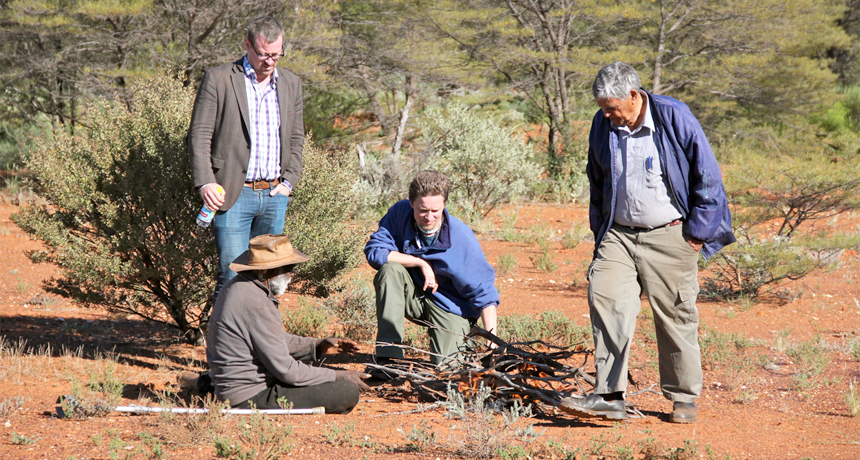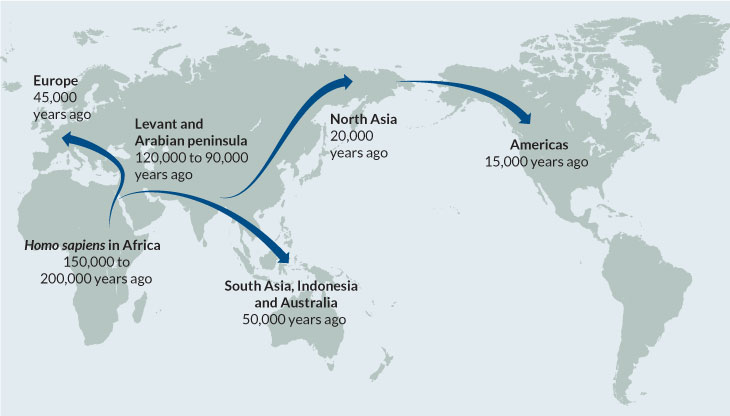Globe’s non-Africans all descend from a single move out of Africa
Genetics and climate science disagree on how long ago that ancient migration occurred

Eske Willerslev (standing, left) and colleagues met with elders in the aboriginal community in the Kalgoorlie area of western Australia. To learn about the genetic history of people in the region, the researchers examined DNA from 83 aboriginal Australians. They also looked at the DNA of 25 people from the highlands of Papua New Guinea.
Preben Hjort/Magus Film
All non-Africans alive today can trace their roots back to ancient humans who left Africa between about 72,000 and 50,000 years ago. That’s the conclusion of three separate groups of scientists. They all published new studies online September 21 in Nature.
These studies examined DNA from different groups of modern people. The earliest human explorers left Africa in a single wave of migration, each study concluded. Then those explorers bred with Neandertals and spread across the world. On that much, all these teams agree. But many details of that history remain unanswered.
Scientists often have wondered when humans first left Africa. And did it happen once, twice or many times? Archaeological evidence from modern humans in Asia dates back 80,000 years. And human DNA from remains of a Neandertal woman in what’s now Siberia suggested some humans left Africa more than 110,000 years ago.
But all of those people later died out, says Swapan Mallick. They didn’t contribute DNA to today’s non-African societies, argues this scientist. He works at Harvard Medical School in Boston, Mass. There, he studies how genes change across the generations. Mallick was part of a team that did one of the new studies.
His group traced the genetic history of 300 people from 142 different populations around the world. Those data indicate that ancestors of today’s non-Africans left Africa only some 50,000 years ago.

A second group of scientists also described a single wave of migrants out of Africa. Their new analysis suggests the group left closer to 72,000 years ago. Or so reports study coauthor Eske Willerslev. Like Mallick, Willerslev is an evolutionary geneticist. He works at the University of Copenhagen in Denmark.
A third team found bits of even older genes in present-day people. Papua New Guinea is an island nation in the South Pacific. About 2 percent of Papuans’ DNA can be traced back to small bands of humans who likely left Africa 120,000 years ago, says Luca Pagani. Pagani is a biological anthropologist at the Estonian Biocentre in Tartu. (Estonia is a country in northern Europe bordering Russia.) Pagani says the older genes show there was an earlier migration from Africa that indeed “was successful in leaving descendants today.” (The majority of the Papuan genome, however, comes from people who left Africa fewer than 75,000 years ago.)
Willerslev’s study included Papuans as well as aboriginal Australians. His team didn’t find traces of a 120,000-year-old migration. It also, however, could not rule this out. Australians and Papuans descend from some of the earliest modern human explorers, they note. As such, their genetic history may be different from other non-Africans.
All three groups present their findings in papers published October 13 in Nature.
How important are the different trajectories?
Pagani’s group seems to disagree with the findings of the other two. But it is a small difference, points out Joshua Akey. He is an evolutionary geneticist. He works at the University of Washington in Seattle and was not involved in any of these studies.
All three groups used different data. They also used different research methods. But importantly, they all tell a similar story. “The main conclusion,” notes Akey, “is that the vast majority of ancestry in non-Africans can be traced to a single out-of-Africa dispersal.”
Other details of this major human migration remain murky. For example, the research teams report different patterns of movement after people left Africa.
Willerslev’s team suggests ancestors of Europeans and Asians stayed put for thousands of years in the Middle East. Eventually, they parted ways. Ancestors of Australians and Papuans, in contrast, kept walking. “These guys were heading off on this marvelous journey across Asia,” Willerslev says. They reached Australia and Papua New Guinea some 50,000 years ago.
Mallick and his colleagues agree with part of this story. They also believe that the African migrants lived first in the Middle East and mixed with Neandertals. Then they split into two groups. One group ended up in Europe. The other populated Asia. But Mallick’s team says that Australian and Papuan ancestors didn’t sprint ahead. They initially were part of the Asian migration. They moved on to the islands only later.
Climate science questions the new dates
Scientists like consistency between studies. It seems to suggest they are correct. That’s why a fourth new study is a bit of a spoiler. It relies on totally different types of data to argue that the “out of Africa” trip took place far earlier than the geneticists would suggest.
This fourth study focused on ancient climates. And it was published online in Nature on the same day as the other three. It argues that the years of migration predicted by the genetic studies were dry. Extremely dry. In fact, this paper’s authors argue, it would have been the absolute worst time to leave Africa.
So maybe they didn’t leave then after all? That’s what the authors of this study conclude.
Axel Timmermann is a climate scientist at the University of Hawaii at Manoa. He explains that Earth wobbles on its axis in a cycle — known as precession — that takes roughly 20,000 years. That precession triggers massive changes in Earth’s climate and vegetation. Over that time, the route out of Africa can go from a welcoming green path to a parched desert.
Timmermann and his coworker Tobias Friedrich used computers to model how Earth’s climate and sea levels changed during the last 125,000 years. Those changes, they propose, can predict when and where humans might have easily moved.
Based on climate, early humans would have struggled to leave Africa 60,000 to 70,000 years ago, they now report. “Northeastern Africa was completely dry. It was one of the worst drought periods in the entire history,” Timmermann says. Food would have been hard to find. Conditions would have been harsh. For millennia, they say, the exit from Africa would have been closed.
In contrast, during good times people might have left Africa without even realizing it. Maybe they were following food animals, Timmermann says. Climate conditions were probably better between 107,000 and 95,000 years ago and again 90,000 to 75,000 years ago. He thinks people probably started moving out of Africa about 100,000 to 80,000 years ago. The next good window wasn’t until 59,000 years ago.
By then people were likely well on their way to Australia.
Story continues below image.

“People could have chased antelope across and they wouldn’t even know they were on a different continent,” Timmermann says. If the landscape didn’t appear to change, they wouldn’t have known they had moved out of Africa — or back again, as movements of game and weather patterns changed. This transition would have been mirrored in people’s mating habits. As peoples moved in and out of Africa, they would have been free to mix freely, he speculates.
Genetics experts look for changes in DNA between groups of people to determine when the groups went separate ways. Yet most genetic analyses haven’t taken any back-to-Africa movement into account, Timmermann notes.
Back-and-forth mating would initially make the Africans and non-Africans appear identical — in terms of their genes, anyway. So people who kept going back and forth to Africa and mating with people in each place would all look genetically like one big “African” family.
Allowing for such a mingling in and out of Africa puts the exodus of people from the continent at about 100,000 to 80,000 years ago. Climate shifts 70,000 years ago turned Arabia to desert. That would have ended the cross-border travels and mixing, Timmermann says. Only then would the people already outside Africa evolve in their own particular ways. This would finally leave them genetically distinct from people still living within Africa.
Taken together, the four new studies offer a deep but incomplete picture of early human history. In the future, scientists may combine genetic studies from present-day people with archaeology and work on ancient DNA. This may allow them to find answers to some of the nagging questions.







